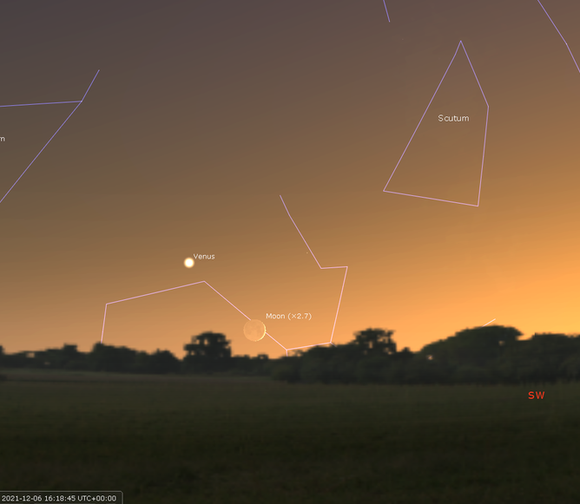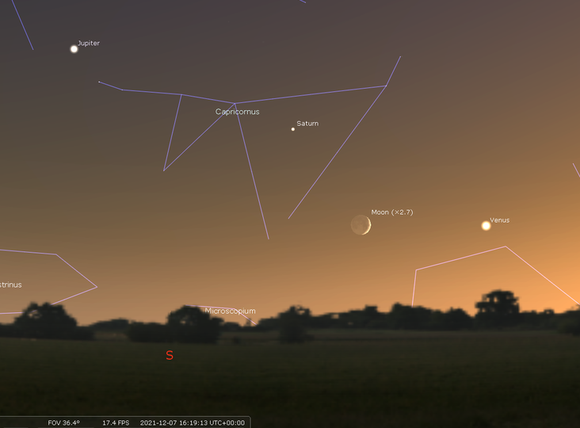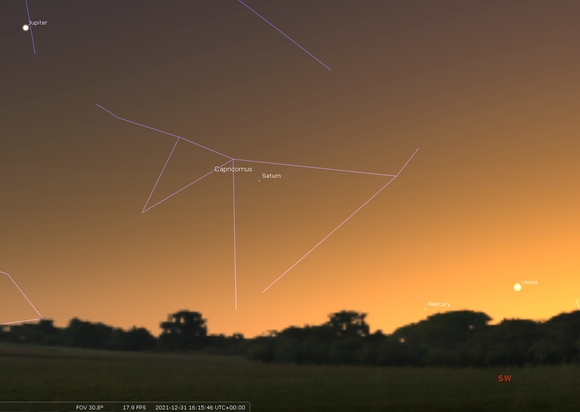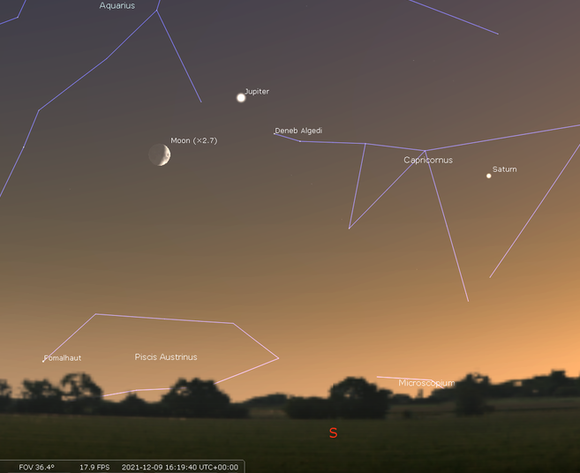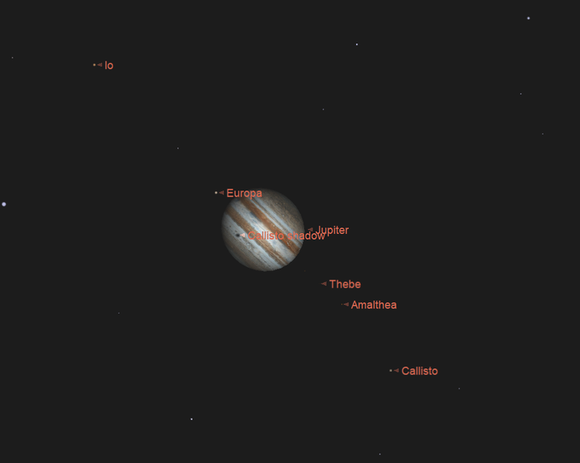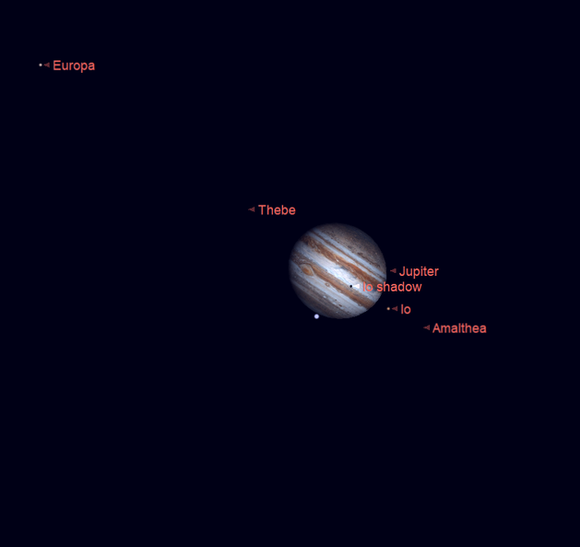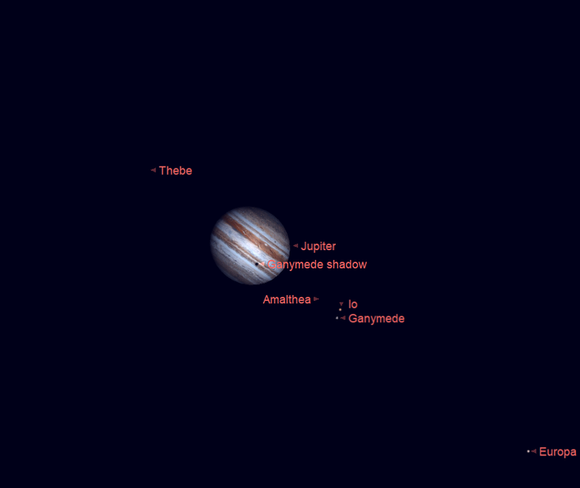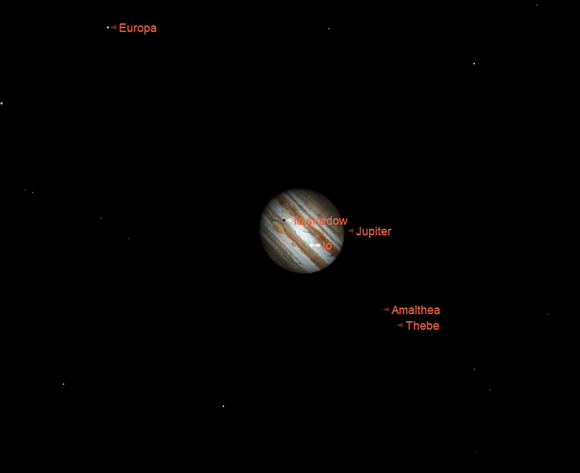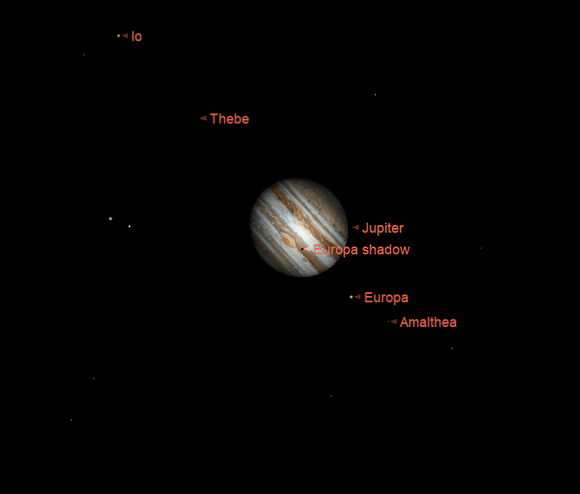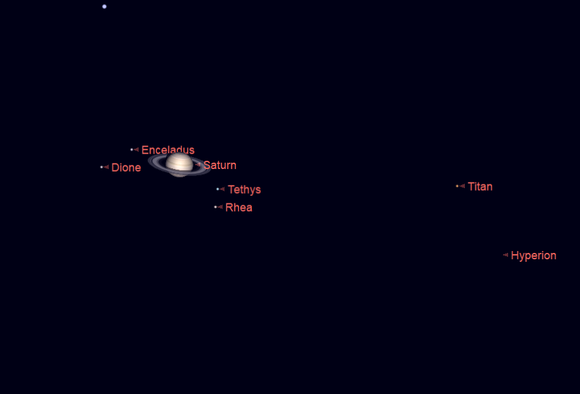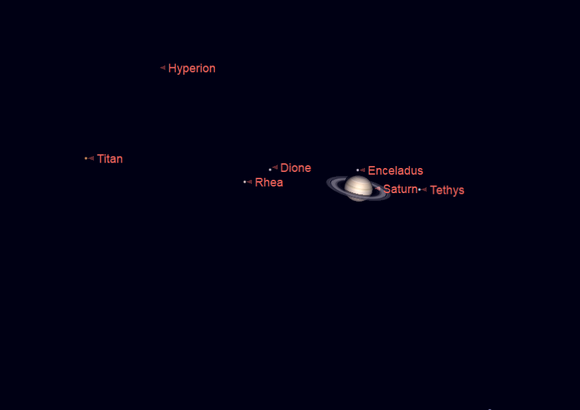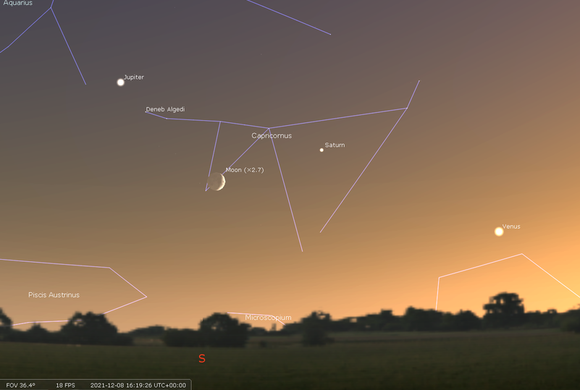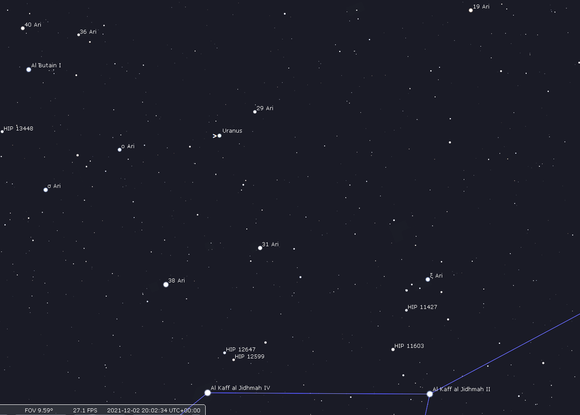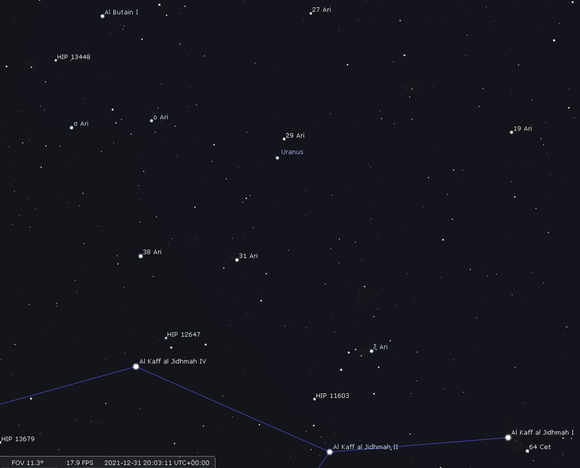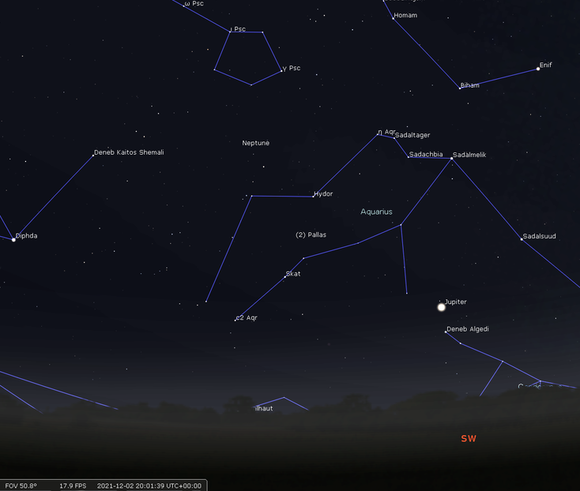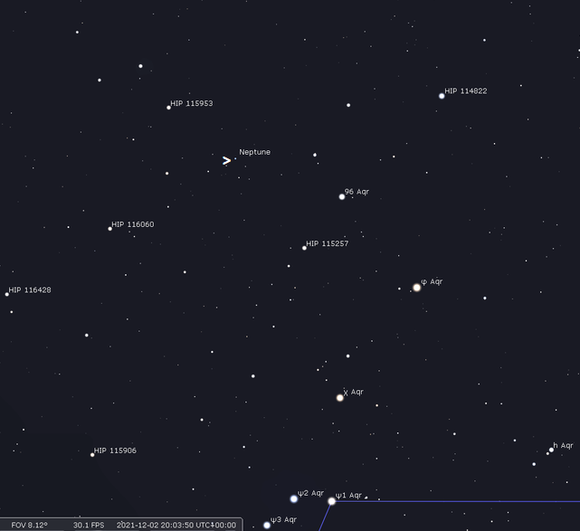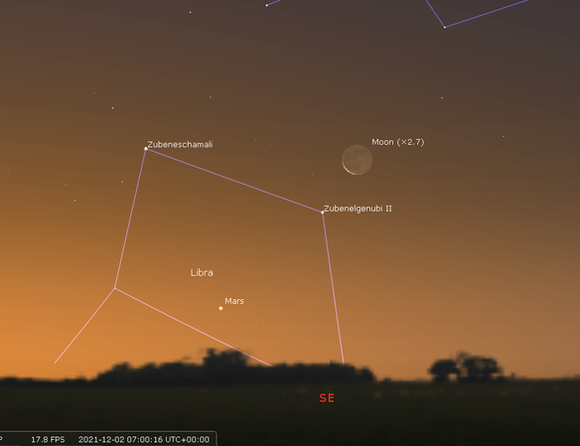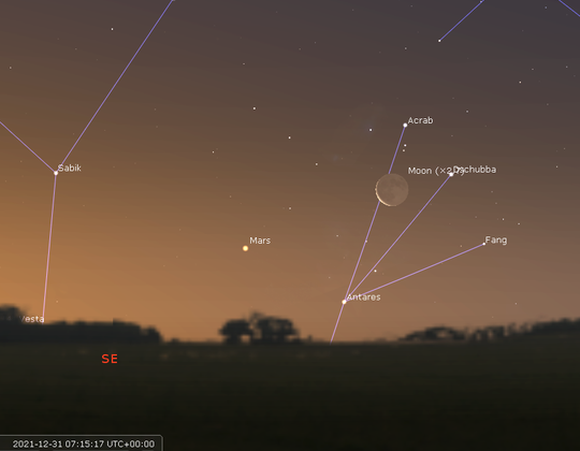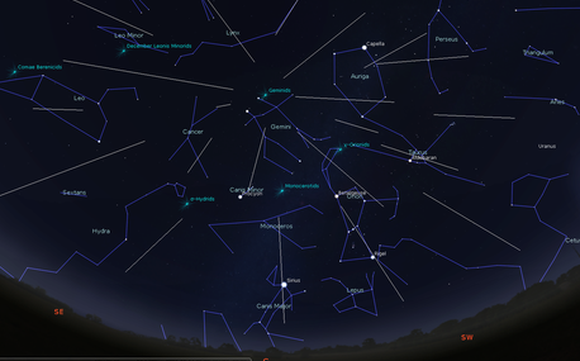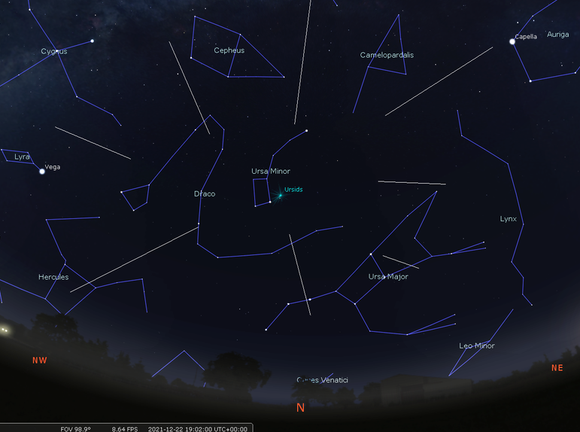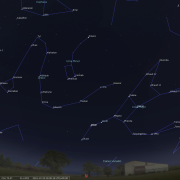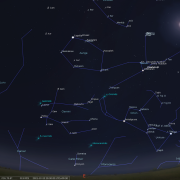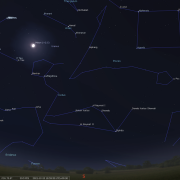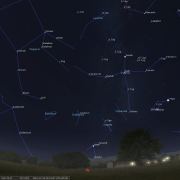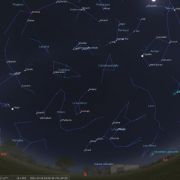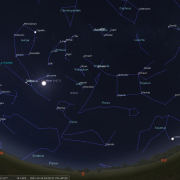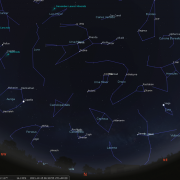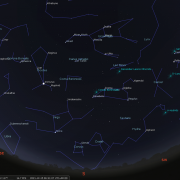In this month's Sky Notes:
Planetary Skylights - Brief
 After spending most of the summer and autumn month skulking low above the west horizon, Venus finally becomes more noticeable, playing the role of 'evening star'. You will still require an unobstructed SW aspect to spot Venus, but at magnitude -4.6 it is exceedingly bright and slighter better placed, having gained a few more degrees in altitude, attaining almost 15 degrees from mid UK latitudes. View 30-40 minutes after sunset and look for the brightest object low in the SW sky. Venus will be readily visible for just over an hour, so make the most of any observing opportunities as by the final week of the year Venus drops rapidly back toward the horizon. Through the eyepiece Venus exhibits a crescent phase, though little else is visible. If skies are clear on Dec 6th look for a wafer thin crescent moon at 16:15hrs lower right of Venus and just above the horizon. The following evening the slender crescent may be glimpsed to the right of Venus at a similar time.
After spending most of the summer and autumn month skulking low above the west horizon, Venus finally becomes more noticeable, playing the role of 'evening star'. You will still require an unobstructed SW aspect to spot Venus, but at magnitude -4.6 it is exceedingly bright and slighter better placed, having gained a few more degrees in altitude, attaining almost 15 degrees from mid UK latitudes. View 30-40 minutes after sunset and look for the brightest object low in the SW sky. Venus will be readily visible for just over an hour, so make the most of any observing opportunities as by the final week of the year Venus drops rapidly back toward the horizon. Through the eyepiece Venus exhibits a crescent phase, though little else is visible. If skies are clear on Dec 6th look for a wafer thin crescent moon at 16:15hrs lower right of Venus and just above the horizon. The following evening the slender crescent may be glimpsed to the right of Venus at a similar time. December 6th @ 16:15hrs GMT (click for full image)
 Following in the wake of Saturn, Jupiter is slighter better placed for observation, especially early in the month, but it too will become increasingly more challenging to observe in any detail as we head toward the New Year. Make the most of any observing opportunities that present themselves before Christmas. Residing in western Capricornus Jupiter remains a conspicuous (magnitude -2.1) naked eye object above the SSW horizon as dusk falls. Jupiter is now in prograde motion; moving west to east against the background stars and will shortly drift back into Aquarius. The waxing crescent Moon sits lower left of Jupiter in the evening twilight sky on December 9th. Binoculars will reveal the Galilean moons as specks of light on the equatorial plain, larger binoculars may also reveal some disk detail, but a small telescope is required to appreciate the Jovian system.
Following in the wake of Saturn, Jupiter is slighter better placed for observation, especially early in the month, but it too will become increasingly more challenging to observe in any detail as we head toward the New Year. Make the most of any observing opportunities that present themselves before Christmas. Residing in western Capricornus Jupiter remains a conspicuous (magnitude -2.1) naked eye object above the SSW horizon as dusk falls. Jupiter is now in prograde motion; moving west to east against the background stars and will shortly drift back into Aquarius. The waxing crescent Moon sits lower left of Jupiter in the evening twilight sky on December 9th. Binoculars will reveal the Galilean moons as specks of light on the equatorial plain, larger binoculars may also reveal some disk detail, but a small telescope is required to appreciate the Jovian system.
Through the telescope eyepiece Jupiter is a magnificent sight, with plenty to interest all levels of observing experience. The bright disk is noticeably oblate and spans 40 arc seconds. Look for the darker banding across the disk and perhaps some subtle colouration. The Great Red Spot (GRS) feature appears to be an ever present storm system, but over recent decades has diminished in size and colour intensity. There are signs this trend may be reversing, so it's good to keep tabs on. The GRS can be seen on Jupiter from 18:00hrs and before 20:00hrs on the following dates; December 2, 4, 9, 10, 11, 13, 16, 21, 3, 28 & 30th.
Jupiter is flanked by the Galilean moons' seen as specks of light close by. The 'dance' of the Galilean moons around the planet throws up a different configuration each night. If you have a 4" (100mm) aperture scope' and above, shadow transits of moons passing on the near side of Jupiter will be visible, jet black dots of varying size dependant on which moon is involved. The actual moons themselves are more difficult to spot as they pass in front of Jupiter, requiring larger apertures. The most favourable shadow transits this month are on the following dates and times. Io - 16h @ 18:00hrs; 23rd @ 18:30hrs. Europa - 28th @ 18:30hrs. Callisto -10th @ 19:00hrs. Ganymede -22nd @ 17:30hrs.
 Saturn is nearing the end of its apparition for this year and as the month progresses viable observing time diminishes as Saturn descends into more unstable air above the SW horizon. Observe early in the month as soon as dusk falls when Saturn is still 18 degrees in altitude to have to have a fighting chance of more stable views. To the naked eye Saturn appears quite conspicuous with an apparent magnitude of +0.7. The magnificent ring system is orientated with the North Pole tilted toward Earth by almost 17 degrees. This angle is slowly closing up with respect to Earth taking another 4 years before we arrive at the next ring plane crossing event.
Saturn is nearing the end of its apparition for this year and as the month progresses viable observing time diminishes as Saturn descends into more unstable air above the SW horizon. Observe early in the month as soon as dusk falls when Saturn is still 18 degrees in altitude to have to have a fighting chance of more stable views. To the naked eye Saturn appears quite conspicuous with an apparent magnitude of +0.7. The magnificent ring system is orientated with the North Pole tilted toward Earth by almost 17 degrees. This angle is slowly closing up with respect to Earth taking another 4 years before we arrive at the next ring plane crossing event.
Should 'seeing be stable, views of Saturn through the eyepiece will be quite respectable, with a disk size of 18.5 arc seconds plus the rings. A scope with an aperture of 80-100mm (3.5-4") will reveal the two brightest rings; ring A (the outermost) and ring B. These are separated by the Cassini Division. Ring C lies closest to the disk and is more difficult to spot, especially when 'seeing' is unsteady, normally requiring scopes of 150mm (6"). Saturn has at least 60 moons most of which are very small, but you should at least spot Titan, its largest moon as a speck nearby. Titan is bright enough (mag+8.4) to be spied in binoculars and takes just under 16 days to orbit round Saturn. Scopes of 200mm + (8") will also reveal Rhea, Tethys and Dione as well as Iapetus. The Moon lies below Saturn on Nov 10th.
 Uranus is now well placed for observation in the evening sky; albeit with a telescope. It is culminating due south around 21:00hrs by mid December almost 54 degrees in altitude, well clear of any unstable air, assuming general seeing conditions are fine. Uranus is located in the southern reaches of Aries, but is actually closer to the head of Cetus than the crooked line of stars marking Aries itself. At magnitude +5.8 it is technically visible to the naked eye, but only from very dark locations and with good knowledge of where to look. This is perhaps the most difficult aspect in spotting Uranus; actually indentifying the general area of sky it currently resides, being in 'no man's land' and largely devoid of naked eye stars. Roughly speaking it lies 10 degrees below the chief star in Aries - Hamal. The nearest 'bright' apparent stars through binoculars are omicron Ari and 29 Ari at magnitude 5.7. Uranus sits between them, but is moving toward the latter and by the end of December Uranus lies almost directly below it.
Uranus is now well placed for observation in the evening sky; albeit with a telescope. It is culminating due south around 21:00hrs by mid December almost 54 degrees in altitude, well clear of any unstable air, assuming general seeing conditions are fine. Uranus is located in the southern reaches of Aries, but is actually closer to the head of Cetus than the crooked line of stars marking Aries itself. At magnitude +5.8 it is technically visible to the naked eye, but only from very dark locations and with good knowledge of where to look. This is perhaps the most difficult aspect in spotting Uranus; actually indentifying the general area of sky it currently resides, being in 'no man's land' and largely devoid of naked eye stars. Roughly speaking it lies 10 degrees below the chief star in Aries - Hamal. The nearest 'bright' apparent stars through binoculars are omicron Ari and 29 Ari at magnitude 5.7. Uranus sits between them, but is moving toward the latter and by the end of December Uranus lies almost directly below it.
At a distance of 2.8 billion Km (1.78 billion miles) not surprisingly the disk of Uranus appears rather small through a telescope; just 3.4 arc seconds and exhibits a bland, ghoulish grey/green lustre, even in larger instruments of 200-300mm aperture. Scopes of 300mm+ will however reveal two of Uranus's moons; Oberon and Titania, if seeing is good.
 Neptune remains well placed for telescopic observations as darkness falls some 32 degrees above the SSW horizon. Neptune is located midway between the faint loop of stars marking the western fish in Pisces, and Aquarius. The nearest visible naked eye to Neptune being phi Aqr at mag +4.2 located a few degrees to the west. Through binoculars the nearest 'conspicuous star' is 96 Aqr. Currently at a distance from Earth of approximately 4.3 billion km (2.7 billion miles) Neptune is a little tricky to track down and at magnitude +7.7 requires at least a decent pair of binoculars to spot it. In reality a telescope of 100mm aperture is required to make out the tiny blue/grey disk, which is less than 2 arc seconds across. See chart for location details.
Neptune remains well placed for telescopic observations as darkness falls some 32 degrees above the SSW horizon. Neptune is located midway between the faint loop of stars marking the western fish in Pisces, and Aquarius. The nearest visible naked eye to Neptune being phi Aqr at mag +4.2 located a few degrees to the west. Through binoculars the nearest 'conspicuous star' is 96 Aqr. Currently at a distance from Earth of approximately 4.3 billion km (2.7 billion miles) Neptune is a little tricky to track down and at magnitude +7.7 requires at least a decent pair of binoculars to spot it. In reality a telescope of 100mm aperture is required to make out the tiny blue/grey disk, which is less than 2 arc seconds across. See chart for location details.
Dawn Planets
 Mars has crept away from solar glare enough for it to be seen once again low in the dawn sky. It will be a little bit of challenge to spot though; certainly a clear unobstructed view of the SE horizon is a prerequisite. For the time being regard Mars as a visual naked eye or binocular target only, being several months away from becoming a semi-viable object for telescopes. That said, stacked images may yield results. View on Dec 2nd and again on Dec 31st @ 07:00hrs and 07:15hrs respectively when a waning crescent moon resides upper right of Mars. By the New Year Mars lies to the left of Antares ('rival of Mars') and chief star in Scorpius.
Mars has crept away from solar glare enough for it to be seen once again low in the dawn sky. It will be a little bit of challenge to spot though; certainly a clear unobstructed view of the SE horizon is a prerequisite. For the time being regard Mars as a visual naked eye or binocular target only, being several months away from becoming a semi-viable object for telescopes. That said, stacked images may yield results. View on Dec 2nd and again on Dec 31st @ 07:00hrs and 07:15hrs respectively when a waning crescent moon resides upper right of Mars. By the New Year Mars lies to the left of Antares ('rival of Mars') and chief star in Scorpius.
Meteors - November Activity.

Meteor activity reaches a peak at this time of year with two major meteor showers occurring within the space of 20 days. The chance of spotting a shooting star or two is therefore pretty high - weather permitting! First up are the Geminids, considered to be the most prolific annual meteor shower. The Geminids are active from December 7-16, reaching a peak this year in the early morning hours of December 14th. Geminid debris stems from a small asteroid called Phaethon which may even be the nucleus of a ‘dead’ comet. Phaethon passes within ten million miles of the Sun causing the object to deposit material over great swathes of the inner solar system. It is only within the second half of the 20th century that Geminid activity has increased to the levels now recorded, a result of Earth passing through a much denser debris strand, a situation that will only continue for another hundred years or so. The shower radiant lies close to Castor, in Gemini, visible in the east by 6pm. Under ideal conditions the Zenith Hourly Rate (ZHR) exceeds 100; however observed rates are always lower. A typical Geminid meteoroid is about the size of a large coffee granule, brighter Geminids regularly produce long luminous trails, sometimes green or orange in hue. A waxing gibbous moon will hamper observations on the evening of the 13th, however by the early morning hours of the 14th when Geminids reach a peak, the moon will be setting. By then Gemini will be high to the south.
Conditions for the less prolific Ursid meteor shower are much more favourable. The shower is active from Dec 17-25th, peaking on Dec 22/23rd, Hourly rates of around 10 are the norm, but occasionally and erratically, Ursids can produce strong outbursts, so it may be worth keeping an eye open that night. The radiant lies close to Kockab in Ursa Minor.
As we head into the New Year look out for the Quadrantid meteor shower, yet another prolific shooting star ‘fest’ with peak rates exceeding 100 in the early morning hours of the 4th. Therein lies the problem with this particular shower, the peak is almost always in the early morning hours and is short lived, usually a couple of hours. More on this shower next month.
December Comets
December has potentially four comets available for UK observers to spot with large binoculars, a small telescope, or image. None of them are going to blow your mind, but beggars can’t be choosers! Comet (A1 2021 Leonard) is poorly placed from UK shores, mired in pre-dawn twilight in the constellation of Ophuichus during its closest to Earth on Dec 12th, just 34.4 million km distant. Before then it is just about visible in the early morning sky, passing through Bootes north of Arctuus. On the 3rd it lies 7 arc minutes south of the globular cluster M3 approximately 20 degrees above the east horizon at 04:00hrs. The comet is heading southwards all the while though, which is a pity as it may well reach magnitude 6, just within naked eye reach and readily visible in binoculars, making it the brightest of the 4 comets on show.
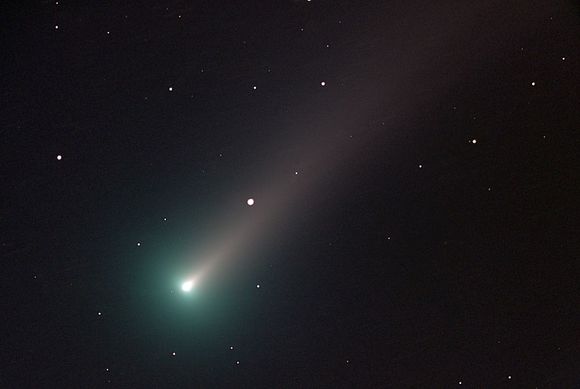
Comet A1 2021 Leonard. Image - University of Herfordshire Observatory
Comet 67P/Churyumov-Gerasimenko has now passed through perihelion coming closest to Earth on November 12th. At magnitude +10.3 it certainly is not going to win any prizes, but will be available in small-medium sized instruments or imaging set-up platforms. It is not expected to deviate from the predicted light curve. You will locate 67P tracking through northern Cancer through December - around 45 degrees up in the ESE by midnight. Comet 67P/C-G is one of the best-studied comets; you will recall ESA's Rosetta spacecraft rendezvoused with it in 2014, sending the Philae lander to the comet’s surface before the year's end. Overall, the spacecraft travelled with the comet for two years.
Comet 2019 L3 (ATLAS) shines around mag +9 and is closest to Earth on Jan 6th and to the Sun 3 days later. The term 'closest' is perhaps not the correct descriptive choice of words as the distances inolved are 385 million km and 531 million km respectively. For the first couple of weeks in December Comet 2019 L3 tracks through the extreme SW corner of Lynx before a brief visit into Auriga and then passing into Gemini by December 18th. By the New Year the comet will be almost 70 degrees in altitude and will be visible in modest scopes, perhaps sporting a stubby tail, which will be apparent in images.
Finally, Comet 19P Borrelly is yet another 9th magnitude comet appearing as an early evening object by the last week of December as it climbs up through the lower reaches of Cetus. It will come closest to Earth on Dec 11th, 175 million km distant. As we head into 2022 Borrelly will become more favourably placed as it tracks northward through Pisces and Aries. It reaches perihelion on Feb 1st and may reach mag +7.5.
For accurate charts and position of comets please visit https://theskylive.com
And Finally - The Winter Solstice
The Winter Solstice falls on December 21st this year when the Sun reaches its lowest position in the sky (just over 12 degrees above S horizon at local noon) The tilt of the northern hemisphere away from the Sun has now reached its maximum and useful daylight amounts to just 7 ½ hrs - the shortest day. Latest sunrise and earliest sunset however do not occur on this date. The Sun rises latest around the 28th and sets earliest mid-month. Astronomical winter commences at the winter solstice date, at least in the northern hemisphere; time to dig out the thermals.
November 2021 Sky Charts
Additional Image Credits:
- Planets and Comets where not otherwise mentioned: NASA/ESA
- Sky Charts: Stellarium Software and Starry Night Pro Plus 8
- Log in to post comments

